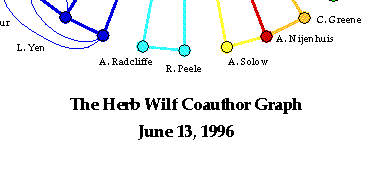
On June 12 - 15, 1996, a Conference on Combinatorics and Graph Theory was held
at the University of Pennsylvania to honor Herb Wilf and his many
contributions
to mathematics and mathematicians; on that occasion we also
celebrated his 65th birthday. This special issue of the Electronic Journal of
Combinatorics is a collection of papers by students, coauthors and friends
who were among the 186 participants who gathered
to pay tribute to Herb Wilf -- an outstanding mathematician
and a truly wonderful teacher.
The mathematics of Herb Wilf can be divided into three main phases.
First was numerical analysis where Herb did his Ph. D. dissertation
(under Herbert Robbins at Columbia University in 1958) and his first
papers
were written.
Next was complex analysis and the theory of inequalities, in particular,
Hilbert's inequalities restricted to n variables.
There was a cluster of papers by Herb, some with de Bruijn and some with
Harold
Widom.
The main area of Herb Wilf is combinatorics. In 1965, Gian-Carlo Rota
came to the University of Pennsylvania to give a colloquium talk on his
then-recent work on Mobius functions and their role in
combinatorics.
Herb recalled, "That talk was so brilliant and so beautiful
that it lifted me right out of my chair and made me a combinatorialist
on the spot." The next year, Herb had a sabbatical leave in London
and he spent his time in the library at Imperial College
going through every paper in combinatorics since the creation of the world.
By the end of the year, Herb had proved
that the chromatic number of a graph
is at most 1 plus the largest eigenvalue of its adjacency
matrix with equality only as in Brooks' theorem, thus
making
his debut in combinatorics.
Since then, Herb has had a profound influence in numerous areas of
combinatorics, analysis, graph theory, discrete algorithms
and, in particular, in generating functions through his pioneering work,
with
Doron Zeilberger, in
computerized proofs of combinatorial identities.
Long before most researchers and educators, Herb Wilf recognized
the important connections between computers and mathematics.
As early as his undergraduate years at MIT (1951), he took summer
jobs at IBM in Manhattan where there was a mainframe IBM 701 designed by
von Neumann. With Tony Ralston, he wrote a program implementing a
multistage linear regression analysis, following a method developed
by Mike Efroymson, then of Esso Corp.
The program was used by Esso (now Exxon) to
control the
quality of refined gasoline. Together, Wilf and Ralston edited the
book Mathematical Methods for Digital Computers, and two more
volumes followed a few years later. In Herb's graduate years, in order
to support his growing family, he took partial
and full time jobs as the head of computing section
with a small staff of one (himself)
at Fairchild Engine Division and also at Nuclear Development Associates.
His work there included calculating eigenvalues of a proposed jet engine
design on the IBM CPC, generating random objects and using Monte Carlo methods.
After he received his Ph.D. and became a professor, the computer continued
to play a key role in both his research and teaching. He and Albert
Nijenhuis masterfully integrated FORTRAN
with combinatorics as seen
in their
book Combinatorial Algorithms. His celebrated work
with
Petkovsek and
Zeilberger concerns computer-automated proofs which
has expanded the notion of mathematical proofs and resulted
in a recent book
A=B .
Herb Wilf has co-founded two major journals, Journal of
Algorithms in 1980 with Donald Knuth, and The Electronic Journal
of Combinatorics in 1994 with Neil Calkin, for which he serves
as
an Editor-in-Chief. During his tenure as the editor
for the American Mathematical Monthly (1987-1992), in addition to his
editorial
duties, he wrote a series of illuminating expository articles.

To this date, Herb Wilf has had twenty Ph.D. students, 36 coauthors, eleven books, and over 130 research papers. The clickable images here lead to larger images, designed by Stan Wagon, that display the full list of students and coauthors at the time of the conference.

Fan Chung, special issue editor and conference co-chair
Graphic design by Stan Wagon
Joan Hutchinson, conference co-chair